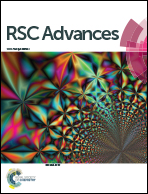Quantitative determination of methylene blue in environmental samples by solid-phase extraction and ultra-performance liquid chromatography-tandem mass spectrometry: a green approach†
Abstract
Industrial effluents with dyes may contain appreciable concentrations of materials with high chemical oxygen demand and suspended solids, posing adverse effects to both humans and aquatic life; therefore, these effluents require quantitative monitoring. In the present study, an analytical method based on solid-phase extraction (SPE) and ultra-performance liquid chromatography-tandem mass spectrometry (UPLC-MS/MS) has been optimized for the quantitative analysis of methylene blue (MB) in environmental samples. For the extraction of MB, a variety of solvents, including formic acid, were investigated to obtain optimum recovery. MB extraction using the SPE method was best achieved using methanol with 1 M formic acid. Chromatographic separation of MB and methylene violet 3RAX (MV 3RAX, internal standard) was accomplished on an Acquity® BEH C18 column using water (64.99%) with formic acid (0.01%) and acetonitrile (35%) in isocratic elution mode. Chromatographic separation for both MB and MV 3RAX was achieved in <2 min with good resolution and superior peak symmetry. MB and MV 3RAX were quantified with electrospray ionization coupled with MS/MS in the multiple reaction monitoring mode. Good quality parameters were achieved for instance linearity (r2 > 0.999), run-to-run and day-to-day precisions with relative standard deviations of <4%, sensitivity with a low limit of detection (LOD) of 0.1 ng mL−1 and limit of quantification (LOQ) of 0.4 ng mL−1 were obtained. Industrial wastewater samples (paper, textile, laundry and printing press) were analyzed, and an MB level was found in between 0.36 and 1.08 μg mL−1 with excellent recovery rates (95–99%) depending on samples.


 Please wait while we load your content...
Please wait while we load your content...